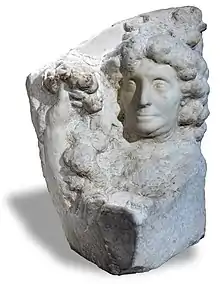Athénaïs Michelet
Athénaïs Michelet (1826–1899), née Athénaïs Mialaret, was a French natural history writer and memoirist.
Athénaïs Michelet | |
|---|---|
 | |
| Born | 1826 |
| Died | 1899 (aged 72–73) |
| Nationality | French |
| Genre | Natural history, memoir |
| Subject | History |
| Spouse | Jules Michelet 1849–1874 (his death) |
Marriage and writing career

Athénaïs married the much older Jules Michelet in 1849. She had first encountered Michelet through his literary work, having written to him for guidance after having read Du prêtre, de la femme et de la famille; at the time she was tutoring the children of the Princess Cantacuzène in Vienna. Their literary conversations remained the basis of their relationship even after their marriage.[1] She and her husband entered into a shared literary life, collaborating on L'Oiseau (1856), L'Insecte (1857), La Mer (1861) and La Montagne (1868). Although these books were published under Jules Michelet's name only, he explicitly credited Athénaïs not only for turning his attention to natural history, but also as an active collaborator.[2] At his death, they were working on La nature.[3]
She subsequently published several books in her own right including Mémoires d'une enfant in 1867. She corresponded with Charles Darwin about cat behaviour,[4] and her book Les chats was published posthumously in 1904. She wrote a book expressly for the English audience that was published as Nature, or the poetry of earth and sea (London: T. Nelson 1872).[5]
Widowhood
Before he died, Jules Michelet accorded Athénaïs literary rights to his books and papers, acknowledging that she had had a significant role in the writing of his later years.[6] Although the will was contested by Jules Michelet's son-in-law, Athénaïs won her case and retained the papers and publishing rights.[6] She published several books about Jules Michelet and his family, based on the extracts and journals he had left her. She bequeathed the literary legacy to Gabriel Monod. The tradition of writing about Jules Michelet thereafter painted Athénaïs as an "abusive widow", exerting sexual control to guide her husband's literary endeavours along her own lines of interest.[7]
References
- Smith, Bonnie. Historiography, Objectivity, and the Case of the Abusive Widow. History and theory 31: 91. JSTOR 2505413
- Lionel Gossman, The alibi of nature: Michelet and natural history, in The World and Its Rival: Essays on Literary Imagination in Honor of Per Nykrog, ed. by Kathryn Karczewska, Per Nykrog, Tom Conley, Amsterdam; Atlanta, GA : Rodopi, 1999, p. 224.
- Ripley, George; Dana, Charles A., eds. (1879). . The American Cyclopædia.
- "Darwin Correspondence Project – Letter 8356 – Athénaïs Michelet, Athénaïs, to Darwin, C. R., 17 May 1872". Retrieved 9 July 2020.
- Lionel Gossman, The alibi of nature: Michelet and natural history, in The World and Its Rival: Essays on Literary Imagination in Honor of Per Nykrog, ed. by Kathryn Karczewska, Per Nykrog, Tom Conley, Amsterdam ; Atlanta, GA : Rodopi, 1999, p. 247.
- Smith, Bonnie. Historiography, Objectivity, and the Case of the Abusive Widow. History and theory 31: 22. JSTOR 2505413
- Smith, Bonnie. Historiography, Objectivity, and the Case of the Abusive Widow. History and theory 31: 15–32. JSTOR 2505413